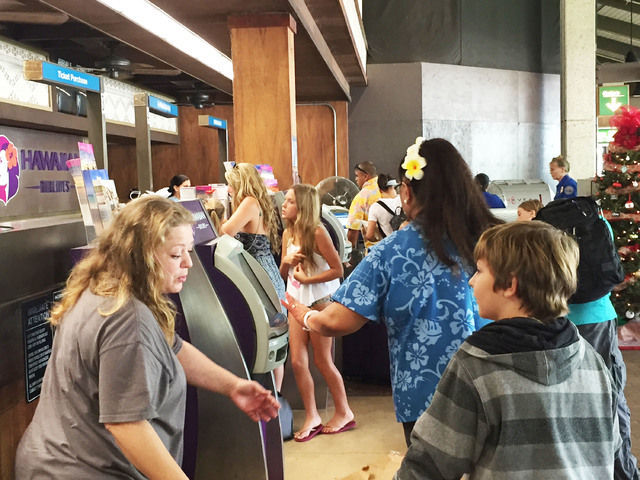LIHUE — Kauai Airports District Manager Dennis Neves’ goal is to make Lihue Airport into one that “is just like any other airport” in America. “What I’m trying to develop is an airport where everything’s processed behind the scenes, and
LIHUE — Kauai Airports District Manager Dennis Neves’ goal is to make Lihue Airport into one that “is just like any other airport” in America.
“What I’m trying to develop is an airport where everything’s processed behind the scenes, and make it look like a real airport,” Neves said.
It all comes down to getting proper funding for future plans, Neves said.
Gov. David Ige released an executive supplemental budget proposal on Dec. 21 for the 2016 legislative session that would increase the overall fiscal 2015-17 budget from $26 billion to $30.7 billion. Included in that amount is $9.2 million for reconfiguring Lihue Airport’s check-in area and holding area to accommodate increasing flights, according to Jodi Leong, press secretary for the governor’s office.
The total remodel project is expected to take around five years to complete, and it could take longer depending on how much cash flows in to fund the various pieces, Neves said.
Not everyone, however, thinks that airport improvements are high enough on the priority list to garner a line item in the governor’s proposal.
“I’m not the governor, but I do feel he should reach out to us, the residents of Kauai, for input on a higher level, because I don’t feel like the airport improvements are necessary right now, as a lifetime resident of Kauai,” said County Councilman Ross Kagawa.
Kagawa said the $9.2 million could be used to help relieve Kauai’s traffic problem.
Councilman Mason Chock also thinks there are “many more needs on Kauai that require attention.”
Neves, however, said the supplemental budget money is much needed, and will “get this moving in the right direction.”
The first phase of improvements will be to clean up the queuing area for the ticketing counters in the front of the airport, Neves said, “so we have more area to process folks.”
“We’ll be filling in the covered garden areas in front of the airport and adding additional queuing space for ticketing check in,” Neves said. “Also we will be covering those open areas, so there will be either skylights or roofing. It opens up the whole front end and gives us more space.”
The plan also relocates the USDA checking areas laterally to the roadway, reducing congestion.
“Turning the USDA laterally keeps lines (of people) from running into lines,” Neves said.
Neves said he also wants to add some additional holding areas and rework the retail shop areas to create more space. He also wants to add two more lanes for the center checkpoint, bringing the number of lanes to five, and eliminate checkpoint three, by the baggage claim area.
“The problem (with checkpoint three) is that it’s very narrow, so if people have medical devices, or they’re in a wheelchair, there’s no access to that area,” he said.
The second phase of the project includes changes to the TSA checkpoint area; expanding gates 5,6,7 and 8 to encompass the hallways; and installing window seating on the garden side.
Neves said he doesn’t expect that phase to have enough money for a couple more years.
“That’ll add about 100 seats to that area, which is well needed, especially when the larger 767 aircraft is in,” Neves said.
The last piece of the project is reconfiguring the way checked baggage flows through the airport.
Neves wants to create an experience “where you come up to the ticket counter and don’t have to see your bag again.”
Neves said the airport is in its current state because when it was created, only two airlines landed at the Lihue terminal: Aloha Airlines and Hawaiian Airlines.
“Today we have six and five of them provide trans-Pacific flights to the Mainland, and Westjet goes to Canada,” Neves said. “All of them are carrying at least 120, maybe 230 passengers per airplane. That’s quite a significant increase in a 10- or 15-year period.”
Neves also wants to add Wi-Fi to the airport.


